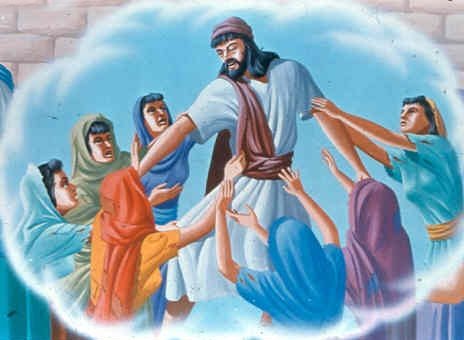


 716
The 7 Ruachot (Spirits) &
716
The 7 Ruachot (Spirits) &
Important Women by Wells

Notes for a Sermon Never Made

Wells are often associated with divine revelation in biblical symbolism. Water is the life-giving substance that symbolises creation and new beginnings. It is not insignificant that Yahweh would choose water sources for places of revelation. In the Sonf of Solomon, the Shulamite woman is praised as a "garden fountain, a well of living water" (SS 4:15).
When Abraham covenanted about a well that he dug, he set apart seven female sheep as "witnesses" of the oath. There is a repetitive pattern of "the woman at the well."
First, there are Abraham's seven female sheep at the well, Beersheba (well of the oath, well of the seven).
Then, there is Rebekah (Rivqah), "the woman at the well", Isaac's bride. Rebekah's name comes from a root rbq means, 'to fetter' (to restrain, to tie firmly). She is 'the Restrainer', acclaimed for her alluring looks, individuality and virtuous nature.
Next, there is Rachel, Jacob's bride, whom he found at a well (Gen.24). Her name means, 'ewe' or 'female sheep'. This is an echo back to Abraham's seven female sheep at the well. The story of Jacob and Rachel teaches us an important spiritual lesson on waiting (he had to marry Leah first), faith, and the complexity of human relationships. The gifting of the two women's maidservants, Zilpah and Bilhah, as Jacob's third and fourth wives reminds us of Yahweh's gifting of Eve to Adam to end his loneliness in the Garden of Eden as a single and of Saul's ex-wives given to David when the former apostacised and was killed in battle.
Then, there is Zipporah ('Little Bird'), "the woman at the well", the second of Moses' two wives, who has six sisters. Like with Abraham, they are seven sister females at the well.
Seven sister birds call to mind the seven brightest stars of the constellation, Pleiades (from the Greek pelaiai, meaning 'the doves' cp. Ruachot) (in Hebrew, 'a heap' or 'collection'; in Latin, Vergillae, the stars of spring), also known as the Seven Sisters, which is alluded to in Revelation 15. It is found in the constellation of Taurus, the bull, a symbol of Ephraim. This constellation is also mentioned in Job (9:9) and Amos and symbolise Yahweh's immense power and creative authority over the universe. Likewise in Revelation 1:16a Yah'shua (Jesus) is portrayed as holding the 7 stars in His right hand, the immediate context interpreting this imagery as His exercising sovereignty over the seven messengers (angels) of the seven congregations (churches) (v.20). Interestingly the Pleiades is exactly 444 (4+4+4=12) light years from the earth, the nearest star cluster to our planet. Their blue colour is striking, linking blue with the number 7 symbolically as also with plural marriage and wisdom = Hochmah = Ruach haQodesh/Holy Spirit.
The primary (visible) lunar phases are roughly 7 days (7.4) each.
7 represents completion or perfection and is used to represent Elohim on account of the 6 days of creation culminating in the sabbath or 7th day.
7 often symbolises the relationship between Elohim and people or the 7 virtues of kindness, severity, harmony, perseverance, splendour, foundation and royalty and relates to the menorah.
Then there are the 7 wells of salvation and the 7 legitimate wives of David
Then there are the seven women of Isaiah 4:1 who propose marriage to a Hebrew man with a shem tov or good (reputable) name as one of the signs of the beginning of the Millennial Reign.
There are seven (female) Ruachot (Spirits) before the throne of Revelation 1 and Isaiah 11. They are the seven eyes that witness redemptive history.
Finally, there is Yah'shua (Jesus) collecting His Bride. He held an important conversation with a Samaritan woman by Jacob's well who had had seven husbands in a row, lost six of them in tragic circumstances with the seventh she was not properly married to (Jn.4:4-6).
Like prayer, water is essential to life and so the symbol for a well is an invitation to come and be with Yahweh. A sacred well is a connecting point.
Further Reading
[1] Emil G. Hirsch, Immanual Benzinger & Schulim Ochser, Well (Jewish Encyclopedia)


This page was created on 3 April 2025
Last updated on 22 April 2025
Copywrite © 1987-2025 NCAY - All Rights Reserved




